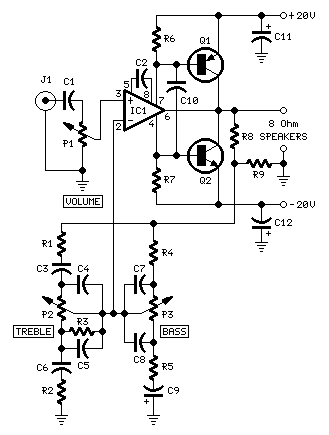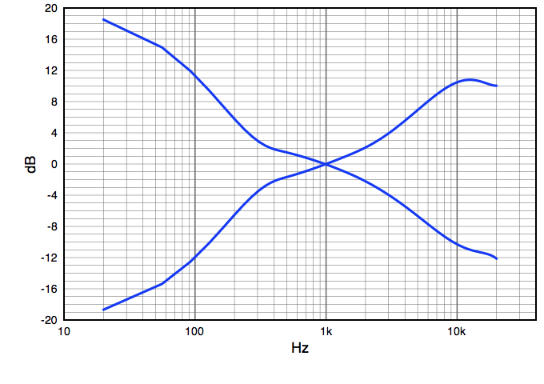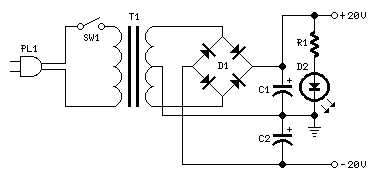Circuit diagram:

Parts:
P1______________50K Log. Potentiometer (or 47K)
(twin concentric-spindle dual gang for stereo)
P2______________20K Linear Potentiometer (or 22K)
(twin concentric-spindle dual gang for stereo)
P3_____________100K Linear Potentiometer
(twin concentric-spindle dual gang for stereo)
R1_____________820R 1/4W Resistor
R2______________68R 1/4W Resistor
R3_______________1K8 1/4W Resistor
R4______________10K 1/4W Resistor
R5_______________1K 1/4W Resistor
R6,R7__________100R 1/4W Resistors
R8_____________330R 1/4W Resistor
R9______________47R 1/2W Resistor
C1_______________1µF 63V Polyester Capacitor
C2______________33pF 63V Polystyrene or Ceramic Capacitor
C3______________10nF 63V Polyester Capacitor
C4,C5____________1nF 63V Polyester Capacitors
C6_____________120nF 63V Polyester Capacitor
C7______________22nF 63V Polyester Capacitor
C8,C10_________220nF 63V Polyester Capacitors
C9______________22µF 25V Electrolytic Capacitor
C11,C12________220µF 25V Electrolytic Capacitors
IC1__________NE5534 Low noise Single Op-amp
Q1____________BD440 60V 4A PNP Transistor
Q2____________BD439 60V 4A NPN Transistor
J1______________RCA audio input socket
Comments:
In order to satisfy repeated requests by correspondents, a medium power audio amplifier incorporating tone controls in the feedback path was finally designed.
To avoid an excessive increase in parts-count, due to the addition of the tone controls, a simple amplifier circuitry was designed on the same guidelines of the successful 45 Watt Class B Amplifier, but using the excellent NE5534 IC instead of a discrete component op-amp to drive the output "dumper" transistors.
The particular circuit configuration, allowed to push the NE5534 exceptional capacity of driving the output transistors near to its limits, enabling the whole amplifier to deliver relatively high power outputs without problems. For this reason, it was possible to obtain 18W into an 8 Ohm load using a power supply voltage of +/- 20V.
Despite the complication added by the tone controls, the amplifier has an input sensitivity of 130mV RMS, allowing to connect directly to its input the most disparate audio sources without the need for a separate preamplifier.
Total Harmonic Distortion figures are astonishingly low, much lower than comparable audio amplifiers using a single-IC audio amp.
An interesting feature of this amplifier is the absence of any kind of setup.
Bass and Treble Frequency Response:

Power Supply Circuit diagram:

Power Supply Parts:
R1_______________1K8 1/4W Resistor
C1,C2_________4700µF 25V Electrolytic Capacitors
D1_____Diode bridge 100 to 400V, 1.5 to 4A
D2______________LED Any type and color
SW1_____________SPST Mains switch
T1______________230V Primary, 30V Center-tapped or 15 + 15V Secondary,
about 45 to 60VA or 1.5 to 2A, Mains transformer
PL1_____________Male Mains plug with cord
Comments:
The power supply is straightforward. The parts values suggested are suited to power a stereo version of this design. For a mono amplifier a less powerful mains transformer can be used, having a 30V Center-tapped or 15 + 15V secondary winding, rated at about 24 to 30VA or 0.8-1A.
Notes:
- Q1 and Q2 power transistors should be mounted on a finned heatsink of at least 100x50x25mm.
- + and - 22V is the absolute maximum permissible voltage supply for NE5534: please do not exceed this limit.
- In the event you obtain a higher voltage from your power supply, you can consider the use of a regulated supply. Please see Simple, Efficient, Regulated Power Supply.
Technical data:
- Output power:
- 18 Watt RMS into 8 Ohm (1KHz sine wave)
- Input sensitivity:
- 130mV RMS for full output
- Frequency response @ 1W RMS and Tone Controls in center position:
- -1.2dB from 50Hz to 15KHz; -3dB @ 20Hz; -2dB @ 20KHz
- Total Harmonic Distortion @ 1KHz:
- 500mW 0.005% 1W 0.0035% 10W 0.0035% 18W 0.008%
- Total Harmonic Distortion @10KHz:
- 500mW 0.007% 1W 0.004% 10W 0.01% 18W 0.024%
- Unconditionally stable on capacitive loads